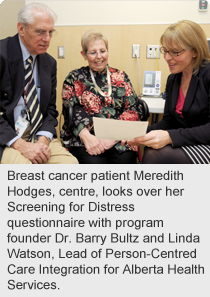
January 14, 2015
Story by Kristin Bernhard; photo by Paul Rotzinger
Meredith Hodges knew breast cancer would take a toll on her body.
But she never suspected it would also take a toll on her marriage.
“The closeness my husband and I shared for so long was not there anymore and I didn’t know how to approach him,” recalls the High River resident, who admits she felt distress over the growing distance between herself and her spouse following her diagnosis.
 Screening for Distress – a provincewide Alberta Health Services program – identified Hodges as a patient who needed additional supports and, as part of the program, resources were made available to address her concerns.
Screening for Distress – a provincewide Alberta Health Services program – identified Hodges as a patient who needed additional supports and, as part of the program, resources were made available to address her concerns.
“The program allowed me to open up about the distress I was feeling,” says Hodges. “The nurse I spoke with knew how to help and recommended a program that was right for me. It helped me understand my own situation and brought me closer to my husband, and he to me. We were ready to face the world again as just the two of us – in a much closer way.”
Hodges is just one of hundreds of Alberta cancer patients who’ve received help from the program for their severe anxiety and mental suffering. The service was developed at the Tom Baker Cancer Centre in Calgary.
Screening for Distress helps front-line staff identify issues that are negatively affecting cancer patients throughout various points of their health care journey, so solutions can be developed to improve their overall well-being. The program, funded by the Alberta Cancer Foundation, was implemented in the province’s 17 cancer centres two years ago.
More than 1,000 patients were assessed as part of a recent evaluation of the program. Results showed Screening for Distress reduced the number of cancer patients who worried about their appearance by 72 per cent, and reduced the number of cancer patients who reported feeling a burden to others by 60 per cent. More than half of all patients reported less frustration and anger after participating in the program.
“While the physical symptoms of cancer are routinely addressed with medical treatment, the psychosocial and practical impact of the disease can go unattended,” says Linda Watson, Lead of Person-Centred Care Integration for Alberta Health Services. “Screening for Distress allows the patient to identify issues so meaningful support can be provided across the entire cancer journey.”
Distress is classified as an unpleasant emotional experience ranging from vulnerability and sadness, to disabling problems, such as anxiety and depression. It can also include eating difficulties, fatigue, financial worries or family concerns.
Unaddressed and untreated, distress can interfere with a patient’s ability to cope effectively with cancer, its physical and psychosocial symptoms, and its treatment.
Patients are asked to complete a brief Screening for Distress questionnaire at various points throughout their cancer treatment. Responses are gathered and staff work with individuals who are experiencing severe distress and develop an action plan to mitigate or eliminate the causes of distress.
“The program has helped to change the approach of health care professionals and how we treat our patients,” says Watson. “It opens up meaningful conversations, allowing patients to talk about what is causing them the most distress.”
Screening for Distress was conceived in the late 1990s at the Tom Baker Cancer Centre by a team led by Dr. Barry Bultz, Clinical Lead of Psychosocial Oncology, Supportive Care and Patient Experience.
Today, distress is now endorsed by more than 75 international organizations and societies, including the Union for International Cancer Control, as the “sixth vital sign” in cancer care, following temperature, pulse, blood pressure, breathing rate and pain.
“Alberta is a champion of whole patient care which promises better patient outcomes and a more targeted and efficient use of resources,” says Dr. Bultz. “We pioneered Screening for Distress in our province and it is now a global standard of care that’s improving patient outcomes around the world and here at home.”
About 16,000 cancer cases are diagnosed every year in Alberta.